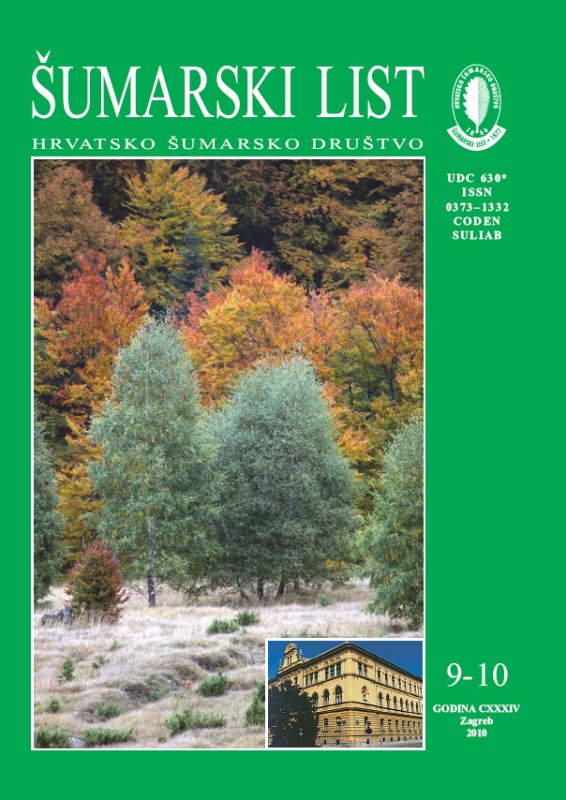
broj: 9-10/2010
pdf (7,71 MB) |
|
||||||||||||||
| RIJEČ GLAVNOGA UREDNIKA | ||
| Branimir Prpić | ||
| THE NEW FOREST LAW pdf HR EN | 445 | |
| IZVORNI ZNANSTVENI ČLANCI | ||
| Pandža,M., V.Krpina | UDK 630* 187 + 188 (001) | |
| Forest Vegetation of the Island of Vrgada and its Islets (Dalmatia, Croatia) pdf HR EN | 447 | |
| Summary: The Vrgada Island with its surface of 2.3 km2 belongs to the group of small islands (Duplančić-Lederet et al. , 2004). It is surrounded by 14 islets and reefs: Murvenjak or Murvenik (0.609 km2), Šipnata (0.085 km2), Oblik (0.074 km2), Kozina (0.063 km2), Gira (0.056 km2), Obrovanj (0.04 km2), Artina (0.033 km2), Veliki Školjić (0.03 km2), Mali Školjić (0.013 km2) and the Rakita, Vrtlić, Lončarić, Kamičić reefs (north of Vrgada) and Kamičić (south of Vrgada). The Vrgada islets and reefs are located in Dalmatia and belong to the Zadar archipelago. The island of Vrgada is made of Senon rudist limestone and alb-cenoman dolomites. Limestone and dolomites alternate with chondrodonts on certain parts of the island. The geological structure of the islets varies from limestone to dolomite (Mamužić et al. 1975). For the Vrgada Island and the surrounding islets there are no climatic data; therefore, the climatic data for Biograd, the nearest weather station on the land, was used in this research. According to the data of the Hydrometeorological Institute of the Republic of Croatia for the period of 1981–2000 the average annual temperature was 15 oC. The annual precipitation was 814.2 mm/m2. Bioclimatically, the island of Vrgada and its islets belong to the bioclimate alliance Quercion ilicis. The vegetation of this alliance belongs, phytogeographically, to the Eumediterranean vegetation zone of the Mediterranean phytogeographic region (comp. Trinajstić 1998). The forest vegetation of the island of Vrgada and the surrounding islets was researched on several occasions during 2009 and 2010 by making relevés. On the island of Vrgada and its islets we found only the Mediterranean-Littoral vegetation belt. The most significant community in this belt is Myrto-Quercetum ilicis and on the south and southwest exposition of the island of Vrgada and its islets it is the xerothermic vegetation alliance Oleo ceratonion and in it ass. Pistacio-Juniperetum phoeniceae. A total of 31 phytocenological relevé was made. The relevés were made and analyzed using the classical Braun-Blanquet‘s method (Braun-Blanquet 1964). All records were subjected to two numerical methods of analysis – the cluster analysis and the multidimensional scaling (Sharma 1996; McGarigal et al. 2000). The numerical analysis was made using the SYN-TAX 2000 program package (Podani 2001). The phytocenological relevés were made and analyzed using the classical Braun-Blanquet method (Braun-Blanquer 1964) and the results are shown in the tables 1–5 whereas the graphic display (Picture 3 and 4) was made by a numerical analysis. We have determined the forest communities of garigues – Erico manipulflorae-Cistetum creticiH-ić 1958 and maquis:Myrto-Quercetum ilicis(H-ić 1963) Trinajstić (1976) 1985, Fraxino orno–Quercetum ilicisH-ić (1956) 1958,Pistacio-Juniperetum phoeniceaeTrinajstić 1987and Querco ilici-Pinetum halepensisLoisel 1971 by means of syntaxonomic analysis. Besides these communities that are easily perceived, a part of the island of Vrgada and a part of the Islet of Artina that were afforested during the 1950es and 60es with Aleppo pine (Pinus halepensisMill.) are now overgrowing into its stands. With this spontaneously spreading Aleppo pine we can find on the island of Vrgada the holm oak maquis, within which the initial stage with the community of garigues and the terminal stage with the community Myrto-Quercetum ilicis Trinajstić (1976) 1985 are distinguished. The garigues on Vrgada develop on grasslands and abandoned olive groves and are currently naturally progressing into evergreen maquis. On the Islet of Murvenjak theMyrto-Pistacietum lentisci(Molinier (1936) 1954) Rivas Martinez 1975) stands continue on the halophytic zone. The pure holm oak forests Myrto-Quercetum ilicisrepresent the terminal phase in the development of the Eumediterranean zone forest vegetation of the East-Adriatic Littoral and of the island of Vrgada and its islets. Key words: Croatia; Dalmatia; istacio-Juniperetum phoeniceae; Myrto-Quercetum ilicis; numerical analysis; the Island of Vrgada and Its Islets | ||
| Pejnović,D., K.Krapinec, M.Slamar | UDK 630* 156 (001) | |
| Hunters in Croatia as a Socio-Geographic Group and their Socio-Demographic Characteristics pdf HR EN | 461 | |
| Šerić Jelaska, L., A. Ješovnik, S. D. Jelaska, A. Pirnat, M. Kučinić, P. Durbešić | UDK 630* 114.6 + 411 (001) | |
| Variations of Carabid Beetle and Ant Assemblages, and their Morpho-ecological Traits within Natural Temperate Forests in Medvednica Nature Park pdf HR EN | 475 | |
| Čas, Miran | UDK 630* 156 (001) | |
| Disturbances and Predation on Capercaillie at Leks in Alps and Dinaric Mountains pdf HR EN | 487 | |
| PRETHODNO PRIOPĆENJE | ||
| Matošević, D., M. Pernek, B. Hrašovec | UDK 630* 453 | |
| First Record of Oriental Chestnut GallWasp (Dryocosmus kuriphilus) in Croatia pdf HR EN | 497 | |
| PREGLEDNI ČLANCI | ||
| Tomićević, J., M. A. Shannon, D. Vuletić | UDK 630* 903 + 907.1 | |
| Developing Local Capacity for Participatory Management of Protected Areas: The Case of Tara National Park pdf HR EN | 503 | |


